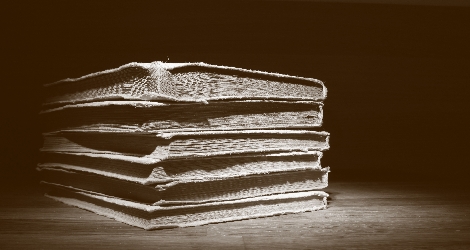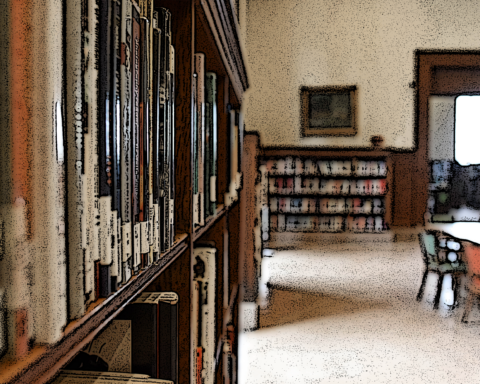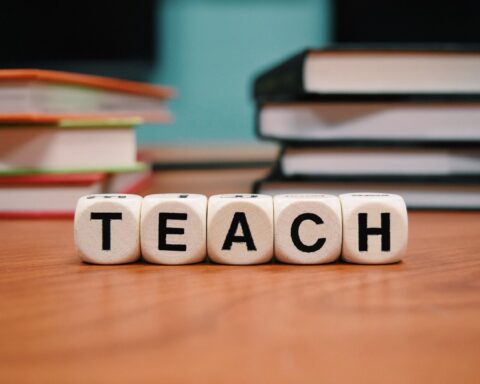A Family Story
Lora and Bruce Whearty, elementary school teachers from Montana, accepted a call to serve as educational mission co-workers through the Presbyterian Church (USA) in 1992. They resigned from their jobs, sold their home and most of their possessions, and moved with their two daughters to Vanuatu, a small island country in the Southwest Pacific. Now, years later, they have returned to their United States, and their now-adult daughter Emily has also taken up the vocation of education as an elementary school teacher at an inner-city school in the West End of Louisville, KY. Lora, Bruce, and Emily have taken a few minutes to reflect on their experiences and this ‘family calling’ to education.
Lora’s Story

When I signed on as a mission co-worker with PC(USA) to go with my family to Vanuatu, I did not have a specific job assignment. Our daughters Emily and Kinsey were two and four, respectively, at the time, so at first my focus was home and family. We lived in faculty housing at a boarding school for grades 7 through 12, run by the Presbyterian Church of Vanuatu. The attached vocational school also included a kindergarten for staff and faculty children, as well as the children from the villages close by. I was asked to teach this kindergarten and to train vocational students interested in becoming kindergarten teachers. Each day started, then, with Emily, Kinsey, and me all going to kindergarten together.
In Vanuatu, ‘kindergarten’ means ‘preschool’. On any given day, we had between 30 and 50 children attending, ranging in ages from 2 to 6 years old. We were given the use of a hurricane-battered, one-room building with a roof of corrugated metal, walls of woven leaves and bamboo, and a concrete floor. Any supplies we had were donated. Sometimes these gifts were given because I had requested them from churches back in the U.S., but usually they were just outdated cast-offs. My biggest challenge was learning to speak the local language as I taught.
___________________________________________
I never knew what to expect when I went to school, so resiliency and adaptability became my watchwords as a teacher.
___________________________________________

I never knew what to expect when I went to school, so resiliency and adaptability became my watchwords as a teacher. Torrential rain storms topped the list of variables. Heavy rains meant that many of the village children would not be making the one-mile walk to school. They also meant that our classroom sounded like the inside of a metal drum. The rain on the roof could get so loud that the children couldn’t hear me tell a story, sing a song, or teach them letters. Our roof would also spring leaks, so we scurried to find dry places for the children’s floor mats, woven out of leaves, and our precious storybooks or toys.
Sometimes I would arrive at school to find that someone had broken into our supply boxes and stolen some of our irreplaceable paper and paints, crayons and chalk, or even some of our toys.
Some days I would arrive at the kindergarten to find that the planned activities at the vocational school had been changed, so my student workers would not be able to fulfill their kindergarten obligations for the day.
The local islanders, well trained by hurricanes and earthquakes, took all these obstacles in stride. I soon learned that it was in my best interests to adopt their approach, to become an islander myself in at least a small way. I gained the ability to keep a positive attitude and, at a moment’s notice, change an activity to fit the current situation.
I have witnessed this same attribute in Emily. As a teacher in an impoverished, inner-city school, Emily is often faced with difficult, confusing, and challenging situations with regards to her students’ personal lives. I believe that as I was learning to be resilient and adaptable during those years in Vanuatu, Emily learned those qualities from me. These abilities have led to her devotion to her students no matter the burdens they carry or the obstacles placed before them.
Bruce’s Story

We’re from Montana, so when Lora and I arrived to teach at a boarding school on the windward side of a small, Pacific Ocean island, there were plenty of unexpected challenges. Yes, we there to teach and to train teachers, but there were many new things for us to learn. For example, I learned how to teach a year-ten agriculture class, with no curriculum or textbooks, and only three months until the all-important national exams. I admitted to the class that I had never seen a coconut tree before. “You teach me about coconuts, and I’ll teach you how to pass your tests!” So the students and I worked together to structure and articulate information, most of which they already knew. Teaching is about admitting your own inadequacies to the students, who recognize them anyway.
I learned that I was able to produce, on one week’s notice, a curriculum for Religious Education for the new year-twelve program. I adapted that year’s Presbyterian Women’s Bible Study from our battered copy of Horizons Magazine, simplified the language a bit for non-native English speakers, and inserted examples from the local culture. I taught the curriculum, and it worked. It was first adopted by the Presbyterian Church of Vanuatu for all of their secondary schools, and later by the Ministry of Education for the entire nation. Teaching is about using and adapting resources in creative ways to meet the needs of the community.
___________________________________________
Teaching, to me, is about helping children let go of your hand and grow into their own wild successes, in turbulent environments far beyond where we their teachers will ever go.
___________________________________________
I learned that a computer and a printer, even when available only part-time (when the school’s generator was working), are powerful resources for a community. I asked a neighboring village what story they would like to publish for their children. They worked together, under the chief’s leadership, and chose a legend from before European contact. They agreed on a ‘standard’ telling, corrected my completely incompetent spelling of their local language, chose a local man to illustrate it, and translated it into four languages. I printed and stapled it, and the village awarded copies as end-of-year prizes for their second graders, who then could read the story of their own village’s founding.

For almost every village home, this little pamphlet, safely stored in a ziplock bag against hurricanes, was the only book they owned. And that story, in all four translations, is now held in the Vanuatu National Archives and in the library of the University of the South Pacific as a printed record of one small piece of the nation’s oral history. Teaching is about empowering a community to tell its story in its own voice, and to let that story be heard.
When we first arrived in the islands, Emily was two. We walked hand-in-hand on the little beaches, protected by the offshore reef where the large waves thundered. Emily would scamper away from every little wavelet, and sometimes even hide behind her mother’s skirt if water touched her feet. She collected shells, safe at the edge of the sea. Later, after we learned to snorkel, I swam with Emily hand-in-hand over the heights and canyons of the reef itself. She would squeeze my hand to get my attention, or pull me toward a particularly beautiful fish or patch of coral. By the time she was a teenager, Emily had taught herself to body surf, and on days when the wind was high, she would ride down the face of collapsing waves and tumble onto the beach in laughing somersaults of sand and spray. From up on the beach, I could only watch in wonder.
Teaching, to me, is about helping children let go of your hand and grow into their own wild successes, in turbulent environments far beyond where we their teachers will ever go. Emily now teaches in just such a scary, challenging assignment. I watch from afar, amazed at her strength and courage as she seeks the windward side of our society, where challenges thunder. Lora and I are very proud of her.
Emily’s Story

I decided I wanted to be a teacher when I was in third grade. Born into a family of teachers, I was surrounded by the profession as I grew up. During my childhood, I watched my parents excel in the profession, both in the United States and overseas. Our family was always focused on helping others, and I knew I wanted a career that would involve making a difference in the world while doing a job I loved.
Another factor that went into the decision to be a teacher was that I had a fairy tale elementary school experience: great teachers (including my parents), a strong friend group, and amazing field trips to places like Yellowstone Park and Crown Butte. I imagined myself teaching a group of similar students in a calm, loving, peaceful environment when I grew up. I knew it was the right choice for me.
As I prepared to become a teacher in college, I didn’t think very seriously about teaching being a vocation. I knew I would help kids, and help make the world a better place, but I didn’t see it as a form of mission until I got my first job. Suddenly, I was teaching fourth grade in one of the toughest inner city schools in Louisville, KY. In terms of test scores, we were at the bottom of the list. In terms of behavior, we had the highest suspension rate of any elementary school in the city.
My class was comprised mostly of students whose families struggled with poverty every day. Most of them were being raised by single parents or grandparents. Almost every child had family members in jail. One child was an orphan, another homeless. I had heard of teaching situations like this, but had not really imagined it for myself. And though I had experienced poverty overseas as a child, I was shocked to see it so blatant here in the US.
___________________________________________
I’ve realized that I have to believe I am meant to be there, or I won’t last much longer. And I want to last. Even through all the frustrations, I find myself loving my students fiercely.
___________________________________________
Pushing my childhood daydreams of teaching aside, I dove in. The day-to-day of the job was brutal. It took months for me to get the students to even be quiet while I was teaching. Fistfights could break out among the students at any moment, over issues as trivial as standing too close to each other or stepping on someone’s shoelace. I struggled each day simply to quell the chaos, let alone teach each academic skill to mastery. The frustrations of the job were numerous: worry about the kids, stress over low test scores, intricate planning of lessons, grade reports, behavior referrals.

Each student in my class had great strengths, but I didn’t have the time to focus on those because I was dealing with seemingly nonstop behavior issues. One of the biggest frustrations was that some of the kids just didn’t seem to care. Who cares about fractions when you don’t know where your next meal is coming from? I worked harder than ever, and – with an amazing support group of friends and my parents by my side – I made it through the year.
I am now in my second year at the same school. Why did I stay? The number of times I’ve answered this question has helped me realize the significance of the job, to the kids and to me.
My response when asked why I stayed is usually, “These kids need good teachers, too.” My willingness and drive to stand up for “these kids,” to cheer them on, to make time to focus on their strengths, and to try to be one small guide in their poverty-stricken lives has brought to light my calling. I’ve realized that I have to believe I am meant to be there, or I won’t last much longer.
And I want to last. Even through all the frustrations, I find myself loving my students fiercely. As I’ve come to realize this, my teaching experience teaching has begun to look slightly more like I’d imagined it in my childhood daydreams. While it is still chaotic at times, I am experiencing more frequent glimpses of peace and calm – and some beautiful moments of incredible kindness. I hold these memories close and keep pushing forward, knowing that each day I’ll be fulfilling my calling in a stronger way than I ever thought possible.
*****
Read more articles from this issue: Pedagogy for the Distressed!





Unbound Social